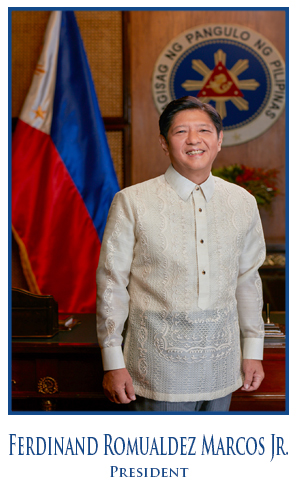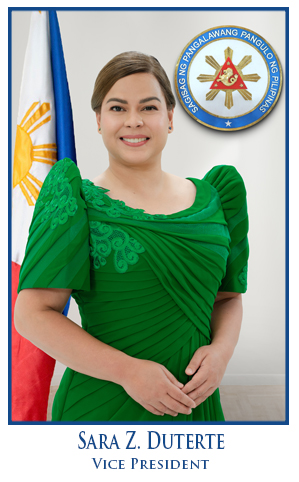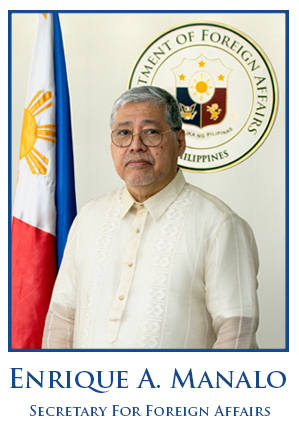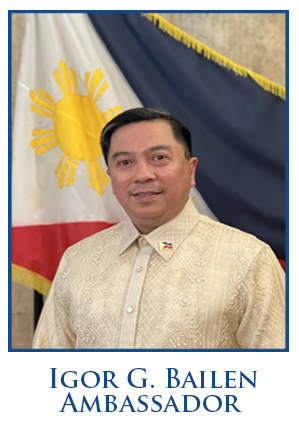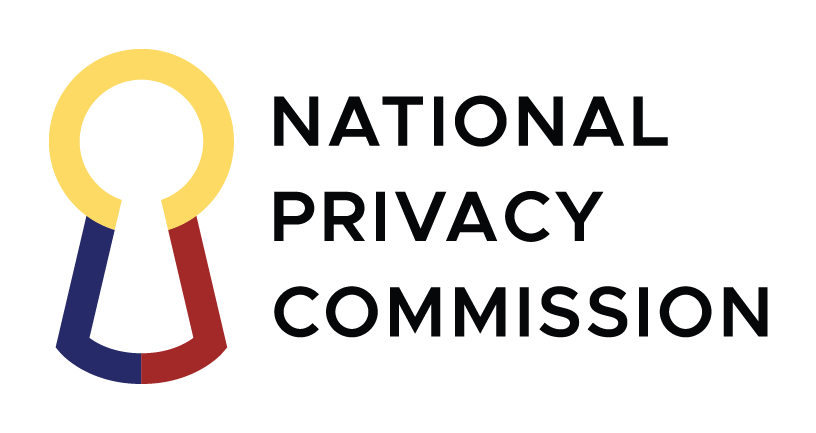OVERVIEW OF PHILIPPINES (PH) –RUSSIAN FEDERATION (RF)
BILATERAL RELATIONS
The history of the Philippine diplomatic mission in Moscow can be divided into two distinct periods: relations with the Union of Soviet Socialist Republics (USSR) from 1976 to 1991 and relations with the Russian Federation and the Soviet successor states from 1992 up to the present.
The Philippines and the USSR agreed to formally establish diplomatic relations during the state visit to the USSR of President and Mrs. Ferdinand E. Marcos from 21 May to 7 June 1976. On 2 June 1976, the Joint Communiqué on the Establishment of Diplomatic Relations between the Philippines and the Union of Soviet Socialist Republics was signed by President Marcos and Mr. Nikolay V. Podgorny, then President of the Presidium of the USSR Supreme Soviet.
Following the dissolution of the USSR in December 1991, the responsibilities and obligations of the Soviet Union arising from bilateral Philippines-USSR agreements were taken over by the Russian Federation, which the Philippines formally recognized on 28 December 1991.
The Philippines and the Russian Federation have since enjoyed cordial and expanding relations.
Philippines-Russia engagement has increased markedly with high-level exchanges of visits and meetings conducted in the past few years, notably the meeting of Philippine President Rodrigo RoaDuterte with Russian President Vladimir Putin at the sidelines of the APEC Economic Leaders’ Meeting in Lima, Peru on 19 November 2016; and President Duterte’s meeting with Russian Prime Minister Dmitry Medvedev at the sidelines of the ASEAN Summit in Vientiane, Lao PDR on 08 September 2016.
During President Duterte’s first meeting with President Putin, both leaders agreed to enhance bilateral relations and cooperation in defense, economic and socio-cultural areas. An invitation to visit Russia was conveyed by President Putin to President Duterte.
During President Duterte’s meeting with Prime Minister Medvedev, the two discussed a wide range of bilateral issues as well as ways which the Philippines and Russia can enhance bilateral relations, particularly in trade and investments, cooperation in combating illegal drugs, and cultural and educational cooperation, among others.
Recent high-level visits to Manila include the visit of Prime Minister Dmitry Medvedev on 18-20 November 2015 for the Asia Pacific Economic Cooperation (APEC) Leaders’ Meeting; Secretary of Security Council Nikolay P. Patrushev on 15-17 February 2017; and Deputy Minister for Economic Development Alexander V. Tsybulskiy, as RF Chair for the PH-RF JCTEC) on 26 January 2017.
Meanwhile, the most recent high-level visit of Philippine officials to Moscow is that of Foreign Affairs Secretary Perfecto R. Yasay and Defense Secretary Delfin N. Lorenzana on 3-6 December 2016. Secretary Yasay called on Foreign Minister Sergey Lavrov, while Secretary Lorenzana called on Deputy Defense Minister Anatoly Antonov and Director Alexander Fomin of the Federation Service for Military Technical Cooperation.
The Philippines and Russia also engage in cordial and active inter-parliamentary relations. Federation Council Chairperson Valentina Matviyenko visited Manila on 10 November 2014. In reciprocation, Senate President Franklin Drilon visited Moscow on 18-23 October 2015, wherein he and Chair Matviyenko signed the “Agreement on Cooperation Between the Council of the Federation of the Federal Assembly of the Russian Federation and the Senate of the Congress of the Republic of the Philippines” on 20 October 2015.
The Philippine Ambassador to the Russian Federation is H.E. Carlos D. Sorreta. The Philippines has Honorary Consulates in Vladivostok, headed by Mr. Yuri M Kostyukov, Consul General, ad honorem; and in St. Petersburg, headed by Mr. Sergey Alexeev, Consul General, ad honorem.
The Russian Federation has a resident diplomatic mission in the Philippines. The Ambassador is H.E. Igor A. Khovaev, who presented his credentials to President Benigno S. Aquino III on 08 June 2015. Russia has an honorary consulate in Cebu City, headed by Ms. Armi Lopez Garcia.
PH-RF JOINT COMMISSION ON TRADE AND ECONOMIC COOPERATION (JCTEC)
The Agreement on the Establishment of the Joint Commission on Trade and Economic Cooperation (JCTEC) was signed by President Benigno S. Aquino III and Prime Ministry Dmitry Medvedev for the Republic of the Philippines and the Russian Federation, respectively,on 18 November 2015 at the sidelines of the APEC Economic Leaders’ Meeting in Manila.
The PH and RF Co-Chairs of the JCTEC, Philippines Department of Trade and Industry Undersecretary Ceferino S. Rodolfo and Russia Deputy Minister for Economic Development Alexander V. Tsybulskiy, held their first Co-Chairs Meeting in Manila on 26 January 2017. During this meeting, the Co-Chairs discussed various areas of cooperation—including trade and investments, agriculture, industry, energy, manufacturing, infrastructure, transport, tourism, science and nuclear technology, labor and higher educated—that will be tabled during the inaugural session of the JCTEC.1 The meeting resulted in the publication of the Joint Statement of the Co-Chairs. (Read it here: http://ow.ly/mz9c30afx0m)
PH-RF BILATERAL TRADE
In 2015, Russia was the Philippines’ 31sttrading partner, 44th export market, and 27th import supplier.
|
Trade2(in US$) |
|||||
|
|
Total |
Exports |
Imports |
Balance |
|
|
2016 (Jan-Nov) |
210,687,588 |
44,189,009 |
166,498,579 |
(122,309,570) |
|
|
2015 |
421,609,749 |
46,311,522 |
375,298,227 |
(328,986,705) |
|
|
2014 |
1,048,270,983 |
67,583,335 |
980,687,648 |
(913,104,313) |
|
|
2013 2012 |
1,357,849,470 1,068,748,959 |
68,370,993 66,487,627 |
1,289,478,477 1,002,261,332 |
(1,221,107,484) (935,773,705) |
|
|
Exports (2015) |
Imports (2015) |
||||
|
|
||||
TOURIST ARRIVALS FROM RUSSIA3
Tourist arrivals from Russia have grown exponentially since 2004, due in part to the 30-day visa-free entry of Russian nationals visiting the Philippines as tourists, instituted on 01 August 2013.
|
2016 (Jan-Oct) |
20,147 |
|
2015 |
25,278 |
|
2014 |
32,087 |
|
2013 |
35,404 |
|
2012 |
28,270 |
REFERENCES
1 Department of Trade and Industry, “Philippines and Russia to Bolster Trade and Investment Ties.” (http://www.dti.gov.ph/about/updates/latest-news/10135-philippines-and-russia-to-bolster-trade-and-investment-ties)
2 Philippine Statistics Authority (PSA) processed by DTI-EMB
3 DOT, Visitor Arrivals to the PH by Country of Residence

